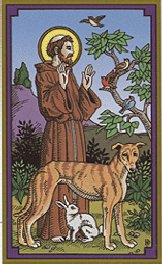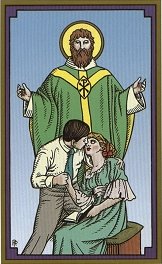This program crashes on some older versions of Internet Explorer.
I would welcome help from a professional programmer.
This is a trick-taking game for three players, using tokens to score.
First, everybody pays 20 tokens to the king pot and 20 tokens to the magician pot.
The dealer of each hand pays 5 tokens to each pot.
When a pot is empty between hands, every pays 20 to it.
You, the human player, begin as dealer.
We imagine that you deal 25 cards to each of the three players,
beginning with the player
at your right, and continuing counter-clockwise.
You keep the three cards left over.
You discard three of the 28 cards you now hold, which score for you.
They cannot be trumps, or meldable.
I understood the rules to be that you reveal these; otherwise the "proprieties"
section in the description would not make sense, because you would not know, at the end
exactly who holds what cards. The machine players will discard only pip cards.
Dealing is rigged so that the dealer will always get at least three pip cards.
Melds are declared and earn rewards for the information.
A player with ten or more trumps must declare the number held, and whether or not I is held.
A player with the Fool, the Magician, and the World must declare the combination, and also the number of additional high trumps in unbroken sequnce below XXI.
A player with four court cards in the same suit must declare them, and whether or not the Fool is held.
A player with three court cards in the same suit and the Fool declares them.
A player with all four kings declares them, and whether or not the Fool is held.
A player with three kings and the Fool declares this, and mentions the suit of the missing king.
Lead any card. Play is counterclockwise, and the first card is led
by the player to the right of the dealer.
Follow suit if you can, otherwise play a trump
if you can. High trump wins the trick, or if there is no trump,
highest card of the suit led wins the trick.
Top to bottom, staves and swords rank KQNPX98765432A, cups and coins
KQNPA12345678X. Winner of the trick
leads to the next.
Each trick counts 1, winning each kings, I and XXI 4, playing the Fool 4 (the fool never wins),
queens 3, knights 2, pages 1.
There is a substantial bonus for winning the last trick, especially with
a king or the I.
There are penalties for playing the king or I to a trick you lose, especially the last one.
I just added the rule that the Fool always be played on or before the third-to-the-last trick.
(One of the machine players will always require this.)
For now, trumps are not discardable. The dealing assures that there will always
be three discardable cards for the dealer.
Naming the fool is now as per the rules.
I did not implement the house-rules reward for winning a not-last trick with I.
Click here
for strategy.
When defending against a known opponent who has shown long in trumps,
the other players will use a king when possible to cover another honor card of that suit
(Page as well as Queen and Knight). A king not held by the player and not show in this way
belongs to the known opponent.
It seems most reasonable to me to think that the Tarot began as playing cards, for entertainment and games, when sufficiently sturdy paper / pasteboard was invented. The suit cards are like our own playing cards.
The trumps present common interfaith symbols that people from many traditions have found helpful in reflection and meditation.
My own experience has been that this can perhaps improve your life if (and only if) your intention is to stop focusing on life's "small stuff" and prepare you to be kind to those around you.
If there are really any intricate cosmic secrets here, I have
been unable to understand them.
Call me dumb or unspiritual if you like.
When I have actually seen the cards used for divination by practitioners,
they were obviously being used as mere props for lay-counselling.
Kings would rank highest, then queens.
Chivalric knights were sworn to serve queens, and pages were squires
to knights. In the trump suit, notice how often a card seems naturally
to take precedence over the one just below it. No reasonable person would deny that the cards are beautiful and meaningful, or claim that this is just a more complex version of "scissors, paper, stone".
* If, as in the old decks, the tower is the "House of God", then the Church defeats
the devil, and nothing below the heavens can take precedence over the Church.
As a kid, I spent quite a bit of time
with Waite's book and the tarot pack. I wondered about his hints
that he possessed
great secret knowledge. (Re-read his description of the "Hanged Man",
look closely at the Ace of Cups,
recall that in his own life he professed the Christian faith,
and then draw your own conclusions.) Today I appreciate him most as the first person
to write systematically about the western occult tradition.
At least some of his Golden Dawn fellow-seekers of "secret knowledge" eventually
found the Ignatian "Spiritual Exercises" more helpful.
Tarot Game Rules -- links to more complicated games with bidding
Waite's Tarocky



The "Latin" suits may represent the military and government (swords),
the clergy (cups),
the business folks (coins),
and the laborers (staves).

The Magician ("juggler", "mountebank" or "sleight of hand artist") may have been introduced first, as a wild card like
our joker for some card games.

The High Priestess was a female pope ("la Papesse"). When it was decided
to introduce a second wild card, a female trickster might have been chosen as the
magician's counterpart. The legend of "Pope Joan" may have attached
itself to the card.

The next three cards may have been introduced together. The Empress would have precedence over the previous two cards, and the four Kings.

The Emperor, of course, is lord over the Empress. The Holy Roman Empire was in existence when the cards were developed.

The Hierophant is probably the Pope, to whom the Emperor owed obedience, at least in theory.

Romantic love has power over every human being. Waite called the first five cards "the captives of Cupid."

War interrupts the lives of Lovers and can take love even out of the human heart.
I've been told that the bonds between comrades-in-arms are stronger than between Lovers.

Strength ("fortitude") gives victory over the enemy Chariots. Socrates's four temporal virtues (fortitude, justice, temperance, and perhaps wisdom / judgement) may all be represented in the images.

The Hermit may originally have been Father Time, who wears down all Strength.

The Wheel of Fortune, or the cycle of Luck, operates through all Time and over the years.

Justice, rather than Luck, should determine what happens to a person.

The Hanged Man is a mystery. Perhaps this is an extrajudicial lynching.
Perhaps this is a cryptic representation of the One Who fulfilled the demands of the law's Justice by His death.

Everything represented up to now is subject to human mortality.

Temperance, living a wholesome life, gives the best chance of staying
healthy and avoiding premature Death.

The devil tempts us to live in ways that are not temperate or otherwise wholesome.

At the destruction of the Tower of Babel, the devil's agents were dramatically defeated. *

The Star shines high above all Towers.

The Moon outshines the Stars.

The Sun outshines the Moon.

At the Last Judgement, the Sun and all rest of creation will disappear.

A card representing a Fool (simpleton) was probably introduced to be playable at any time.

The World contains all the things that can possibly be, and
so it is the highest of all cards. Perhaps this is the
new World that will follow the Last Judgement.
Tarot History
Various Tarot Decks
Tarocchino -- downloadable book of tarot games. No-nonsense account of the history of the gaming cards and the bunko artists who made it an "occult mystery." Thanks!
The Castle of Crossed Destinies -- "semiotic fantasy novel"

Francis of Assisi
Christian Tarot Decks
Tarot and Evangelism -- prof at U. of Aberdeen divinity school. Like any evangelist, meeting "New Agers" where they already are.
Tarot of the Saints -- Biblical and historical images, some gnosticizing
Tarot of the Saints -- Amazon
Tarot of the Saints -- Margaret of Rome resists the devil, etc.

VI. The Lovers
French Tarot for Three
French Tarot for Four
German Cego
German Cego
Hungarian tarot
Konigrufen -- complicated, casual tarot game
Swiss Troccas
Scarto -- primitive tarot game
Meet Ed